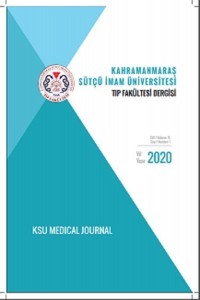Peptik Ülser Perforasyonlarında Nonoperatif Tedavi ve Literatürün Gözden Geçirilmesi
Peptik ülser, Perforasyon, Nonoperatif tedavi
Nonoperative treatment in peptic ulcer perforations and review of the literatüre
Peptic ulcer, Perforation, Nonoperative treatment,
___
- 1. Vijayakumar A, Mallikarjuna MN, Vijayraj P, Ajitha Naika, Shivaswamy BS. Non operative management of perforated peptic ulcer an algorithm approach. Int J Biomed Adv Res 2013;4: 67–72.
- 2. Taylor H. Peptic ulcer perforation treated without operation. Lancet.1946;2(6422) :441-444
- 3. Crofts TJ, Park KG, Steele RJ, Chung SS, Li AK. A randomized trial of nonoperative treatment for perforated peptic ulcer. N Engl J Med. 1989; 320: 970-973.
- 4. Cao F, Li J, Li A, Fang Y, Wang Y, Li F. Nonoperative management for perforated peptic ulcer: Who can benefit? Asian Journal of Surgery (2014) 37, 148-153
- 5. Taş İ, Ülger BV, Önder A, Kapan M, Bozdağ Z. Risk factors influencing morbidity and mortality in perforated peptic ulcer disease. Ulusal Cer Derg 2015; 31: 20-5
- 6. Kim JM, Jeong SH, Lee YJ, Park ST, Choi SK, Hong SC, et al. Analysis of risk factors for postoperative morbidity in perforated peptic ulcer. J Gastric Cancer 2012; 12: 26-35.
- 7. Crisp E. Cases of perforation of the stomach with deductions therefrom relative to the character and treatment of that lesion. Lancet. 1843;2639
- 8. Wangensteen OH. Nonoperative treatment of localized perforations of the duodenum. Minn Med. 1935;18: 477- 480
- 9. Songne B, Jean F, Foulatier O, Khalil H, Scotte M. Nonoperative treatment for perforated peptic ulcer: results of a prospective study. AnnChir2004; 129: 578-82.
- 10. Hanumanthappa M.B, Gopinathan S, Guruprasad Rai D, NeilDsouza. A Non-operative Treatment of Perforated Peptic Ulcer: A Prospective Study with 50 Cases, Journal of Clinical and Diagnostic Research. 2012 May (Suppl-2), Vol-6(4): 696-699
- 11. Nusree R. Conservative Management of Perforated Peptic Ulcer. The Thaı Journal of Surgery 2005; 26:5-8.
- 12. Tarasconi, A, Coccolini, F, Biffl, W.L., Tomasoni M, Ansaloni L, Picetti E. et al. Perforated and bleeding peptic ulcer: WSES guidelines. World J Emerg Surg 15, 3 (2020). https://doi.org/10.1186/s13017-019-0283-9
- 13. Thorsen K, Glomsaker TB, von Meer A, Soreide K, Soreide JA. Trends in diagnosis and surgical management of patients with perforated peptic ulcer. Gastrointest Surg. 2011;15:1329–35.
- 14. Grassi R, Romano S, Pinto A, Romano L. Gastro-duodenal perforations: conventional plain film, US and CT findings in 166 consecutive patients. Eur J Radiol. 2004;50:30–6.
- 15. Yeung K-W, Chang M-S, Hsiao C-P, Huang J-F. CT evaluation of gastrointestinal tract perforation. Clinical Imaging. 2004;28:329–33.
- 16. Malhotra AK, Fabian TC, Katsis SB, Gavant ML, Croce MA. Blunt Bowel and Mesenteric Injuries: The Role of Screening Computed Tomography. J Trauma. 2000;48:991–1000.
- 17. Fujii Y, Asato M, Taniguchi N, Shigeta K, Omoto K, Itoh K. et al. Sonographic Diagnosis and Successful Nonoperative Management of Sealed Perforated Duodenal Ulcer. J Clin Ultrasound 2003; 31:1
- ISSN: 1303-6610
- Yayın Aralığı: Yılda 3 Sayı
- Başlangıç: 2004
- Yayıncı: Kahramanmaraş Sütçü İmam Üniversitesi
Kronik İdiyopatik Ürtikerde Vitamin D Düzeyi
Hülya NAZİK, Kamil MÜLAYİM, Perihan ÖZTÜRK, Mine KUŞ
Habituel Abortus Olan Gebelerde Homosistein Folik Asid ve Vit B12 Seviyelerinin Değerlendirilmesi
Cengizhan YAVUZ, Gökçe GİŞİ, Aykut URFALIOĞLU, Ömer Faruk BORAN, Bora BİLAL, Gözen ÖKSÜZ, Mahmut ARSLAN, Hafize ÖKSÜZ, Hüseyin YILDIZ, Şeyma BAHAR
Peptik Ülser Perforasyonlarında Nonoperatif Tedavi ve Literatürün Gözden Geçirilmesi
Ahmet BOZDAĞ, Barış GÜLTÜRK, Ali AKSU, Nizamettin KUTLUER, Mehmet Bugra BOZAN, Tamer GÜNDOĞDU, Abdullah BOYUK
Hemşirelerin Palyatif Bakımla İlgili Bilgileri
Filiz TAŞ, Dilek SOYLU, Ayse SOYLU
Subdural Hematomun Nadir Bir Nedeni: Enfektif Endokarditi Olan Çocukta Çoklu Septik Beyin Embolisi
Okul Öncesi Dönem Down Sendromlu Çocuklarda D Vitamini Eksikliği
Raikan BÜYÜKAVCI, Mehmet Akif BÜYÜKAVCI
Fibroadenomların İçindeki ve Çevresindeki Histopatolojik Değişikliklerin Karşılaştırılması
İlke Evrim SEÇİNTİ, Didar GÜRSOY
Fibromiyalji Hastalarında D Vitamini Eksikliğinin Fiziksel Semptomlara Etkisinin İncelenmesi
